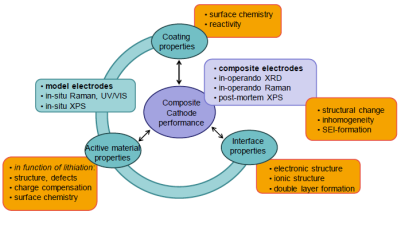
Our research in the field of batteries focus on the following questions: What causes batteries to store less energy over time? Why is there no electric car with a range of 900 km instead of 450 km? How can a battery be made safer? To answer these questions, we need to combine our knowledge of materials science, electrochemistry, and physics of surfaces. Unfortunately, more questions arise. Can we calculate the half-cell potential from material properties? Are the electrolyte and electrode really stable? Why does the voltage of a lithium-ion battery change under discharging? To get answers to all these questions, we are investigating novel cathodes (with less cobalt), high-energy cathodes and new solid-state electrolytes. We combine XPS and electrochemistry to reveal changes in the electronic band structure. For this purpose, we build both laboratory cells and thin-film batteries to bridge the gap between fundamental research and application.
- From particles to thin films: In large scale Li-ion batteries, cathode material is a composite consisting of binder and conductive carbon. To study the intrinsic properties of cathode material, we simplify the battery system by excluding influences like roughness, porosity and effects of binder and other components.
- Quasi in situ: battery material properties are strongly dependent on the state of charge. With stepwise charging/discharging and XPS-measurements we are looking for the correlation between XPS-data and electrochemistry data.
- Novel materials: With a profound knowledge of LiCoO2, we go to the advanced cathode materials like NMC333, NMC622, NMC811 and Mn-rich cathodes. We also look for new solid electrolytes, which are stable with Lithium metal.
- Fundamental understanding: The fundamental electrochemical properties are deeply connected with the electronic band structure of the materials. With measuring work functions, valence band maximum and ionic work function, calculation of the absolute potential of the cathode material is possible (co-operation with University Marburg).









